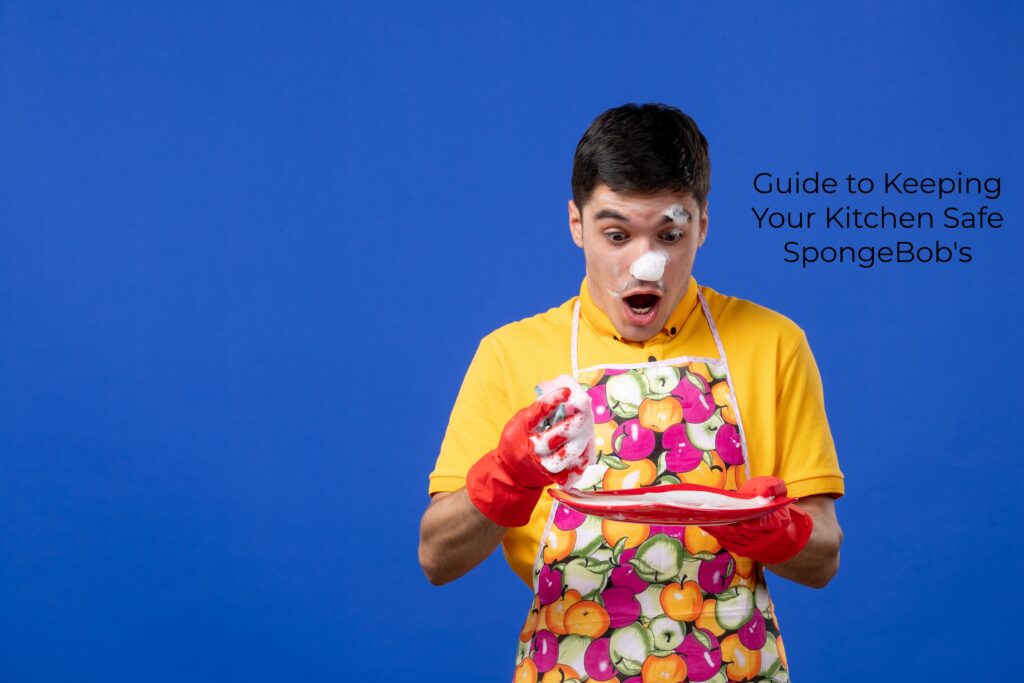Introduction
Here is a guide to keeping your kitchen safe SpongeBob,s is very important.
Remember that iconic episode where a health inspector unexpectedly shows up at the Crusty Crab to visit SpongeBob Square Pants?
Naturally, it’s a comedy goldmine, but beyond the hilarity is a crucial lesson about standards, hygiene, and food safety.

We have everything you need, whether you’re a SpongeBob enthusiast seeking nostalgia or a restaurant owner searching for advice on how to satisfy the health inspector.
Guide to Keeping Your Kitchen Safe SpongeBob's
1. Cleanliness is Next to Sponge-lines
The value of cleanliness is among the most fundamental lessons from the SpongeBob universe.
Every scene at the Crusty Crab features SpongeBob painstakingly cleaning something, whether it’s the kitchen floor or the dishes.
This implies that food handlers and restaurant operators must adhere to stringent regular cleaning schedules.
- Keep Surfaces Clean: High-contact areas should be cleaned often to avoid cross-contamination.
- Clean your hands. Frequently, particularly after handling money or various foods.
2. Proper Food Storage
Table of Contents
There are certain lessons to be learned about food storage from SpongeBob’s fixation with the ideal Crabby Patty. You don’t want to run out of ingredients for your secret formula, do you?
- Remember expiration dates to ensure no rotten ingredients end up in your food.
- To reduce waste and prevent spoiling, clearly designate storage places.

3. Cooking Temperatures Matter
Do you recall the episode where SpongeBob painstakingly prepares a crab patty that is flawlessly golden? For food safety, ideal cooking temperatures must be maintained.
- To make sure food reaches temperatures that destroy dangerous bacteria, use thermometers.
- To prevent cross-contamination, use different equipment for raw and cooked food.
4. Pest Control Isn't Just for the Chum Bucket
When compared to real pests, plankton may be the least of your concerns. But be inspired by how the crusty crab (usually) manages to stay pest-free despite plankton infestations.
- You can keep animals from sampling your culinary creations by sealing food containers.
- Unwanted visitors can be discouraged by routinely inspecting storage spaces and trash cans.
5. Training is Key
A well-trained crew is essential, much like SpongeBob’s endless eagerness to learn (and occasionally overzealous attitude).

- Employee education guarantees that personnel are aware of and abide by food safety regulations.
- Frequent refresher courses teach proper handling and sanitary procedures.
Handling Emergencies with a Smile
One of SpongeBob’s most charming qualities is his upbeat outlook, which is undoubtedly useful in unforeseen kitchen crises.
Even while SpongeBob’s optimism might occasionally cause mayhem, keeping your cool can help you handle possible situations well.
6. Stay Calm and Sponge On
Maintaining composure under pressure prevents problems from getting worse.
- Make a plan: The crew stays organized by being aware of emergency procedures for different situations, such as a fire or equipment failure.
- Communication is Key: To resolve problems quickly, make sure you and your team have open and transparent channels of communication.
7. Equipment Maintenance
As SpongeBob takes care in using the spatula precisely, kitchen equipment maintenance is essential to a smooth operation.
- Frequent Maintenance Checks: To avoid unexpected equipment failures, schedule regular inspections and maintenance.
- Maintain Backup Plans: To reduce downtime, keep extra components on hand for necessary equipment.
These SpongeBob-inspired components not only improve efficiency and safety but also inject some fun into kitchen management.

Despite being animated, SpongeBob’s concepts are applicable in real life, so your kitchen will always be as lively and unforgettable as the Crusty crab.
FAQs
Q: How often should surfaces in the kitchen be cleaned?
A: Surfaces should be cleaned often, especially in high-contact areas, preferably after every usage or at least many times during the day.
Q: What is the best way to train employees in food safety?
A: To make sure staff members stay current on food safety regulations, provide thorough initial training sessions followed by frequent refresher courses.
Q: How can I properly store ingredients to avoid spoilage?
A: Label storage spaces clearly and follow expiration dates. Keeping freshness can also be achieved by using sealed containers.
Q: What are some effective pest control methods?
A: Pests can be avoided by keeping storage rooms clean, closing food containers, and conducting routine inspections. For serious problems, professional pest control services may also be taken into consideration.
Q: How can we handle equipment breakdowns efficiently?
A: Plan regular maintenance inspections and maintain an inventory of spare parts for essential machinery. Additionally, make sure that employees are taught emergency procedures.
Conclusion
Bringing SpongeBob Square Pants’ entertaining yet educational lessons to a real-world kitchen management situation helps improve workplace morale and food safety regulations.
The careful consideration SpongeBob shows for food storage, sanitation, and staff training offers important tips for keeping a kitchen safe and effective.
Restaurant managers may establish a strong framework that not only complies with health requirements but also promotes a happy and peaceful work environment by utilizing SpongeBob’s optimism and readiness.
Like the famous Crusty Crab, your restaurant may become memorable and adored by adopting these teachings, whether it’s preventing pests like Plankton or making sure every dish is prepared to the greatest standards.

Pingback: 1.The Vital Role of Qualified Therapists in Mental Health Support Ultimate Guide - 2024